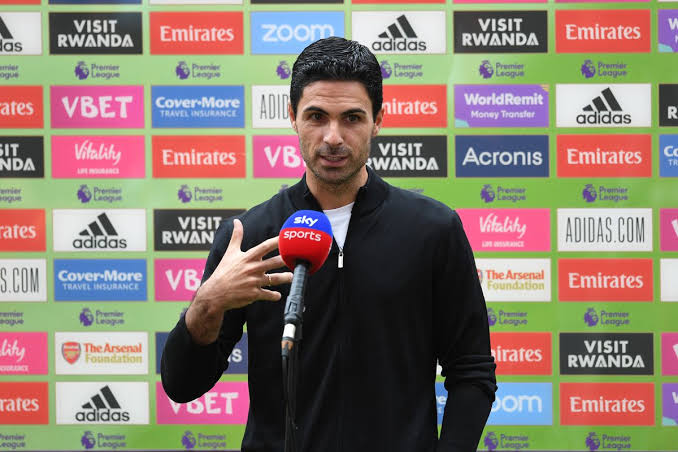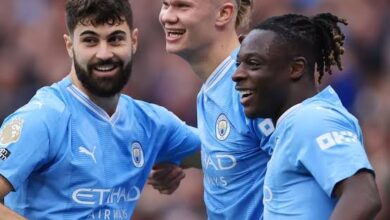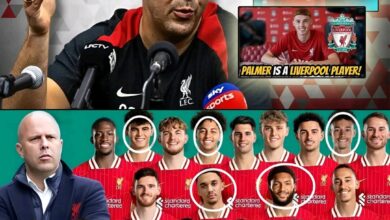Arsenal 3-0 Athletic Club: Viktor Gyokeres off the mark for Gunners who end pre-season with emphatic win 50 minutes ago

As the summer transfer window enters its final phases, Arsenal manager Mikel Arteta has made it abundantly clear that significant changes are still on the horizon for the North London club. In a candid assessment of his squad’s current state, the Spanish tactician has indicated that the Gunners’ transfer business is far from complete, with both departures and potential new arrivals expected before the window slams shut.
“Let’s see what happens in terms of where the squad is in the next few weeks, but we are actively looking at options as well. There are a few players maybe that may have to leave as well,” Arteta revealed in his latest press conference, painting a picture of a club still very much in transition mode.
This statement represents more than just typical transfer window speculation; it signals a manager who remains unsatisfied with certain aspects of his current squad composition and is willing to make bold decisions to achieve his vision for Arsenal’s future. The implications of these words stretch far beyond simple roster management, touching on tactical evolution, financial planning, and the club’s long-term competitive ambitions.
Mikel Arteta’s approach to squad construction has been methodical since his appointment as Arsenal manager. Unlike managers who prefer incremental changes, Arteta has consistently demonstrated a willingness to make significant alterations when he believes they serve the greater good of the team’s development. His latest comments suggest this philosophy remains unchanged, even as Arsenal has established itself as a genuine Premier League title contender.
The manager’s reference to players potentially leaving indicates a ruthless pragmatism that has become a hallmark of his tenure. Throughout his time at the Emirates, Arteta has shown no hesitation in moving on from players who don’t fit his tactical blueprint or meet his exacting standards, regardless of their reputation, transfer fee, or previous contributions to the club.
This approach has yielded remarkable results. Arsenal’s transformation from mid-table mediocrity to Champions League regulars and title challengers can be directly attributed to Arteta’s willingness to make difficult decisions regarding personnel. The departures of players like Pierre-Emerick Aubameyang, Mesut Özil, and others, while controversial at the time, ultimately proved beneficial for the club’s trajectory.
Arsenal’s transfer strategy cannot be viewed in isolation from the club’s financial constraints and objectives. The Premier League’s Profit and Sustainability Rules (PSR) have forced clubs to be increasingly creative in their approach to the transfer market, and Arsenal is no exception. Arteta’s suggestion that “a few players maybe that may have to leave” likely reflects the club’s need to balance their books while still pursuing their sporting ambitions.
The modern transfer market operates on a complex web of valuations, amortization schedules, and financial fair play considerations. For Arsenal, player sales aren’t just about clearing squad space; they’re essential for generating the funds necessary to pursue their primary targets. This delicate balancing act requires precise timing and strategic thinking, elements that Arteta and the club’s technical director Edu have consistently demonstrated.
The manager’s acknowledgment that the club is “actively looking at options” suggests that Arsenal’s recruitment team continues to monitor the market for opportunities. This could involve loan deals, late-window bargains, or situations where other clubs are forced to sell due to their own financial pressures. The key is maintaining flexibility while adhering to a clear strategic vision
When examining Arsenal’s current squad through the lens of Arteta’s comments, several areas emerge as potential candidates for both incoming and outgoing transfers. The depth chart in certain positions suggests natural areas where streamlining might occur, while other positions may still require reinforcement.
In the attacking third, Arsenal has accumulated significant depth over recent windows. The presence of multiple players competing for similar roles creates both healthy competition and potential redundancy. Young talents who may not see sufficient playing time could be candidates for loan moves or permanent transfers, allowing them to develop while generating funds for the club.
The midfield represents another area of interest. Arsenal’s midfield has been transformed over recent seasons, but the balance between defensive solidity, creative output, and dynamic pressing remains a work in progress. Arteta’s tactical evolution continues to demand specific attributes from his midfielders, and those who don’t fit the evolving blueprint may find themselves surplus to requirements.
Defensively, Arsenal has invested heavily in recent windows, but the depth and versatility of the squad could still be enhanced. The modern game demands defenders who can contribute significantly to the attacking phase, and this evolution in role requirements may influence future personnel decisions.
Perhaps the most intriguing aspect of Arteta’s recent comments relates to his assessment of Viktor Gyokeres’ first goal for the club. “That first goal is always very very important, the way he took it as well,” the manager noted, highlighting the significance he places on new signings making immediate impacts.
Gyokeres’ successful integration into Arsenal’s attacking structure represents more than just another transfer success story. The Swedish striker’s arrival signals Arteta’s commitment to adding proven goal scorers who can contribute immediately rather than long-term development projects. This pragmatic approach to recruitment reflects Arsenal’s current position as a club that expects to compete for major honors.
The manner of Gyokeres’ first goal—taking his chance with confidence and composure—embodies the mentality Arteta seeks to instill throughout his squad. First impressions matter enormously in football, particularly for attacking players whose confidence can significantly impact their subsequent performances. The fact that Arteta specifically mentioned the quality of the finish suggests he sees promising signs in the striker’s early displays.
This successful integration may influence Arsenal’s approach to future attacking recruits. The club appears to have identified the profile of striker that thrives in Arteta’s system, and this template could guide future recruitment decisions. The emphasis on technical ability, tactical intelligence, and mental strength—all attributes Gyokeres has displayed—provides a blueprint for Arsenal’s continued evolution in the final third.
Arteta’s system continues to evolve, and these tactical developments naturally impact personnel requirements. The manager’s brand of football demands specific attributes from players in each position, and as the system becomes more sophisticated, the margin for error in recruitment decisions diminishes.
The modern Arsenal setup requires defenders who can progress the ball effectively, midfielders who can press intensively while maintaining positional discipline, and forwards who can create and finish chances while contributing to the team’s pressing structure. Players who excel in some but not all of these areas may find their opportunities limited as the team’s tactical identity becomes more refined.
This evolution explains why established players might suddenly find themselves facing uncertain futures despite previous contributions. Football is an unforgiving business where past achievements don’t guarantee future opportunities, particularly under managers with specific tactical visions like Arteta.
Arsenal’s approach to the transfer market must also be viewed through the lens of their academy production. The club has invested heavily in youth development, and the emergence of talented young players naturally impacts squad planning. The success of academy graduates like Bukayo Saka, Emile Smith Rowe, and others demonstrates the potential return on investment from internal development.
When Arteta mentions potential departures, some of these may involve young players who require regular playing time to continue their development. The modern loan system provides opportunities for promising youngsters to gain experience while remaining Arsenal players, but some situations may call for permanent moves with appropriate buy-back clauses or sell-on percentages.
This academy consideration also influences incoming transfers. Arsenal must balance the need for immediate reinforcement with the requirement to provide pathways for their young talents. This delicate equilibrium requires careful planning and sometimes difficult decisions about which areas to address through recruitment versus internal development
The timing of Arteta’s comments, coming relatively late in the transfer window, adds another layer of significance to his words. Historically, the final weeks of transfer windows see increased activity as clubs become more willing to negotiate and players push for moves. Arsenal’s position as buyers and sellers in this market gives them leverage in negotiations while also creating urgency around certain decisions.
Late-window moves often represent the best value opportunities, as selling clubs face pressure to complete deals before losing assets for nothing. Arteta’s acknowledgment that the club is “actively looking at options” suggests Arsenal is prepared to capitalize on such opportunities should they arise.
Conversely, the pressure to move players who aren’t in the manager’s plans intensifies as the window progresses. These departures are crucial not just for squad harmony but also for financial planning and compliance with various regulations governing squad sizes and wage bills
Arsenal’s transfer strategy must also account for their return to Champions League football and the increased demands this places on squad depth. European competition requires a broader group of reliable players capable of performing at the highest level across multiple competitions simultaneously.
The quality of opposition in the Champions League demands that Arsenal’s squad depth matches their starting eleven’s quality. This requirement may influence both incoming and outgoing transfer decisions, as players who might be adequate for domestic competition may not meet the standards required for European success.
Additionally, Arsenal’s growing reputation as a destination for top talent provides leverage in negotiations while also raising expectations regarding the caliber of players they can attract. This positive cycle of success breeding further success is evident in the club’s recent recruitment, but it also places pressure on the club to maintain these standards consistently.
Behind every transfer decision lies the human element of football management. Arteta’s success at Arsenal has been built partly on his ability to create a cohesive squad environment where players understand their roles and accept the manager’s decisions, even when those ecisions don’t favor them personally.
The prospect of departures requires delicate handling to maintain squad morale while being honest about opportunities and expectations. Players need clarity about their futures to make informed decisions about their careers, and managers must balance this honesty with the need to maintain competitive spirit throughout the squad.
Arteta’s communication style—direct but respectful—has generally been well-received by players throughout his tenure. This approach becomes particularly important during transfer windows when speculation and uncertainty can destabilize squad dynamics if not managed effectively.
Modern football’s regulatory environment significantly influences transfer strategies. Arsenal’s compliance with Financial Fair Play regulations requires careful monitoring of spending patterns and revenue generation. Player sales contribute directly to these calculations, making them essential components of the club’s overall financial strategy rather than purely sporting decisions.
The club’s commercial growth under current ownership has provided increased resources for transfers, but this growth must be sustainable and compliant with governing body regulations. Strategic player sales help maintain this balance while funding continued investment in squad improvement.
Long-term planning extends beyond single transfer windows. Arsenal’s current strategy appears to focus on building a squad capable of sustained success rather than short-term fixes. This approach requires patience and precise timing in both acquisitions and departures.
Arsenal’s transfer strategy must also account for their direct competitors’ activities. The Premier League’s competitive landscape continues to evolve, with multiple clubs capable of challenging for top honors. Arsenal’s recruitment must therefore anticipate and respond to competitive threats while building on their own strengths.
The emergence of Newcastle United as a financial powerhouse, Manchester United’s continued investment, and the sustained excellence of Manchester City and Liverpool all influence Arsenal’s strategic thinking. The club cannot afford to stand still, even after successful seasons, as their competitors continue to strengthen their own squads.
This competitive pressure explains Arteta’s continued search for improvements despite Arsenal’s recent success. The manager understands that maintaining current standards requires constant evolution and improvement rather than satisfaction with existing achievements
As Arsenal approaches what could be a crucial period in their recent development, Arteta’s transfer window comments provide insight into his thinking about the club’s future direction. The willingness to make changes, even to a squad that has performed well, demonstrates the ambitious mindset that has driven Arsenal’s recent success.
The potential addition of new players alongside possible departures suggests a manager who remains unsatisfied with anything less than perfection. This drive for continuous improvement has been a consistent theme throughout Arteta’s tenure and appears likely to continue regardless of the club’s recent achievements.
The integration of players like Gyokeres, combined with the strategic departures Arteta has hinted at, could represent another significant step in Arsenal’s evolution. Each transfer window provides an opportunity to address weaknesses, enhance strengths, and maintain the momentum that has carried the club back to the top table of English football.
Arteta’s comments about potential player movements and his praise for Gyokeres’ early impact encapsulate the ongoing nature of modern football management. Success is never permanent, and the constant pursuit of improvement drives the decisions that shape club futures.
Arsenal’s position as a club capable of attracting top talent while developing their own stars provides options that many competitors lack. This advantage, combined with Arteta’s clear vision and willingness to make difficult decisions, positions the club well for continued success.
The transfer window’s remaining weeks will likely provide clarity on Arteta’s specific intentions, but his recent comments have already revealed the mindset driving Arsenal’s decision-making. Whether through strategic departures, astute acquisitions, or both, the Gunners appear committed to the continuous evolution that has characterized their recent rise.
As fans and observers await the window’s conclusion, one thing remains certain: under Arteta’s guidance, Arsenal will continue to pursue the marginal gains and strategic improvements that separate good clubs from great ones. The manager’s latest comments serve as both warning and promise—warning to current players that complacency won’t be tolerated, and promise to supporters that the club’s ambitions remain as high as ever.
The final weeks of the transfer window will reveal the specific shape of these changes, but Arteta’s intentions are already clear. Arsenal’s project continues, driven by an uncompromising pursuit of excellence that has already transformed the club’s fortunes and shows no signs of slowing down.













